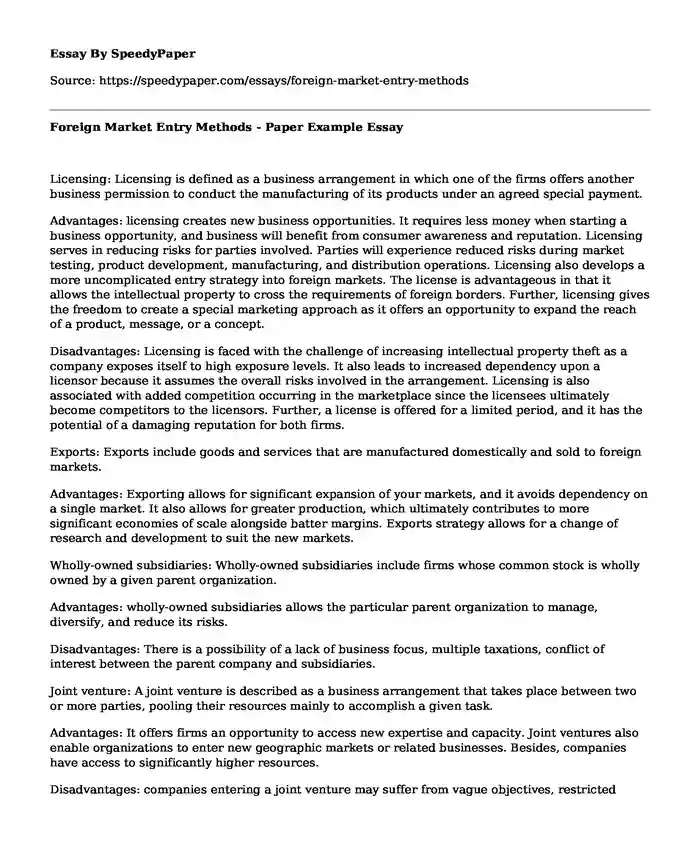
| Essay type: | Process essays |
| Categories: | Company Strategy Marketing International business |
| Pages: | 3 |
| Wordcount: | 648 words |
Licensing: Licensing is defined as a business arrangement in which one of the firms offers another business permission to conduct the manufacturing of its products under an agreed special payment.
Advantages: licensing creates new business opportunities. It requires less money when starting a business opportunity, and business will benefit from consumer awareness and reputation. Licensing serves in reducing risks for parties involved. Parties will experience reduced risks during market testing, product development, manufacturing, and distribution operations. Licensing also develops a more uncomplicated entry strategy into foreign markets. The license is advantageous in that it allows the intellectual property to cross the requirements of foreign borders. Further, licensing gives the freedom to create a special marketing approach as it offers an opportunity to expand the reach of a product, message, or a concept.
Disadvantages: Licensing is faced with the challenge of increasing intellectual property theft as a company exposes itself to high exposure levels. It also leads to increased dependency upon a licensor because it assumes the overall risks involved in the arrangement. Licensing is also associated with added competition occurring in the marketplace since the licensees ultimately become competitors to the licensors. Further, a license is offered for a limited period, and it has the potential of a damaging reputation for both firms.
Exports: Exports include goods and services that are manufactured domestically and sold to foreign markets.
Advantages: Exporting allows for significant expansion of your markets, and it avoids dependency on a single market. It also allows for greater production, which ultimately contributes to more significant economies of scale alongside batter margins. Exports strategy allows for a change of research and development to suit the new markets.
Wholly-owned subsidiaries: Wholly-owned subsidiaries include firms whose common stock is wholly owned by a given parent organization.
Advantages: wholly-owned subsidiaries allows the particular parent organization to manage, diversify, and reduce its risks.
Disadvantages: There is a possibility of a lack of business focus, multiple taxations, conflict of interest between the parent company and subsidiaries.
Joint venture: A joint venture is described as a business arrangement that takes place between two or more parties, pooling their resources mainly to accomplish a given task.
Advantages: It offers firms an opportunity to access new expertise and capacity. Joint ventures also enable organizations to enter new geographic markets or related businesses. Besides, companies have access to significantly higher resources.
Disadvantages: companies entering a joint venture may suffer from vague objectives, restricted flexibility, clash of cultures, more significant imbalance, and increased research and planning.
Direct investment: foreign direct investment describes the business's investment from foreign countries designed to gain a controlling interest in a particular business.
Advantages: companies gain access to market, resources, and reduction in production cost.
Disadvantages: companies face an unpredictable and unstable foreign economy, underdeveloped legal systems, and unstable political systems.
Partnership: This is an arrangement between two or more businesses where people oversee business activities and ultimately share liabilities and profits.
Advantages: it serves to reduce the costs of starting a business. It also provides more capital for the company and increases the capacity of borrowing. Partners enjoy high caliber workers.
Disadvantages: every partner is severally and jointly liable for the debts of the partnership. Besides, the liability of the partners, especially for debts for the company, is restricted. Every partner is held liable for all the debts incurred.
Alliance: in business, an alliance is described as an agreement that occurs between companies. The advantages of the alliance include improved service, especially for the customer and cost reduction. The disadvantages include that businesses may suffer from unequal benefits, merged reputation, increased liability, and lack of control.
Multinational company
An example of a multinational company includes Apple Inc., whose origin is America, and its headquarters are located in Cupertino, California. The company utilizes the identified methods of foreign market entry. The plans have helped Apple Inc. expand its operations in these markets.
Cite this page
Foreign Market Entry Methods - Paper Example. (2023, Aug 29). Retrieved from https://speedypaper.com/essays/foreign-market-entry-methods
Request Removal
If you are the original author of this essay and no longer wish to have it published on the SpeedyPaper website, please click below to request its removal:
- Strategic Management in Tesla Motors, Essay Sample
- Business Essay Sample: Gap Inc. Current Issues Related to Online
- Free Essay: Managing Recipients of Change and Influencing Internal Stakeholders
- Essay Sample on Workplace Ethics and Values
- Free Essay Example on Mobile Banking and Financial Institutions
- Essay Sample. Seven Best Practices for the Supply Chain by 2025
- Paper Example on Value Marketing and 4Ps Marketing Strategies
Popular categories




